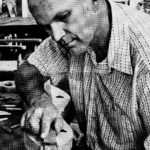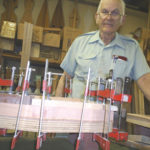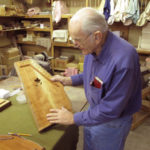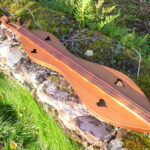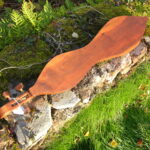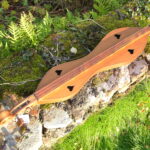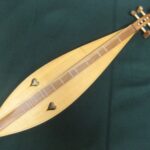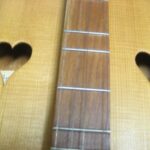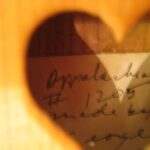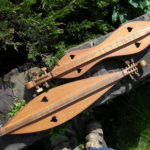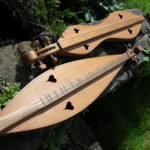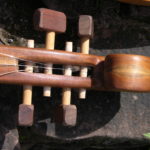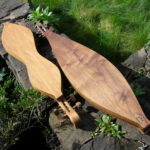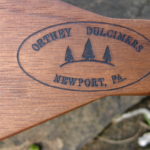George Orthey Dulcimers
Dr George F. Orthey Jr. of Newport was a craftsman of individual quality wooden dulcimers and Autoharps. Born in 1933, he spent 28 years in the Army Veterinary Corps, where his role was in public health, food safety/sanitation and caring for military dogs working around the war zones. While he was stationed at Walter Reed Hospital, he started to work on instruments as a hobby in the army workshop. His then wife, Mary Lou, was musical and he made her a dulcimer “but it was terrible”!
However, his making soon improved and his hobby eventually turned into a full-time business. By 2009, Orthey had made 1,639 dulcimers (which he stopped making some years before) and 1,300 Autoharps (for which he is now more famous). They have all been carefully constructed of selected Appalachian mountain hardwoods. Orthey is especially proud of being asked by country music industry’s legendary Carter family to make a limited-edition dulcimer which now hangs in the Birthplace of Country Music Museum in Bristol, Tenn. “It’s probably worth $25,000 to $30,000,” said Orthey. He credits Mike Seeger for teaching him about the quality of sound of his instruments. “That’s very important to me. I pay attention to what these people tell me. That’s how I learn.’ Below are pictures of George in his workshop, the first from a dulcimer brochure of around 1980, the latter ones within the last 10 years (click to enlarge). Dr Orthey died in August 2020.
3.108 (formerly 3.78) #284 1975 Hourglass £Sold
Handwritten inside on paper slip, “Appalachian Dulcimer/ #284/ Made by/ George Orthey/ Newport, Pa/ July 1975.”
Walnut single piece back and bookmatched sides, with spruce or cedar top. NB No maker’s stamp on back near tail, as on all later instruments. Matt finish. Elegant heart-soundholes with carved tail pointing towards the instrument tail. Narrow walnut open pegbox and sculpted scroll. Originally fitted with typical Orthey wooden friction tuners – square peg ‘buttons’ with fine, maple, tapered shafts. Now has professionally-fitted black Wittner viola pegs, which are internally geared and both look appropriate and work very smoothly. Walnut arched fingerboard (for maximum movement of the top), with brass staple frets under the melody string only; bevelled, slightly lowered strum hollow. Rosewood (?) nut and bridge with traditional wide cut string slots, with the strings slightly offset to the far side. Copper pin string anchors in curved tail. Overall length 34⅛”, upper bout 5⅜”, lower bout 7″, depth 1½”, FBW 1⅜”, VSL 27″ (medium scale), weight 1lb 8 oz (672g). Strings now 12, 12, 24w. No 6+ or 13+ fret.
Design very similar to my own #603. Sound is similarly full and loud, with quite a kick if you hit the melody string hard. Just a few almost invisible scuffs and dings on the edges and the whole body appears to have darkened, but generally excellent for its age.
Click on images below to enlarge.
3.109 (formerly 3.27) #1205 1984 Teardrop £Sold
Hand written, pasted-in label: “Appalachian Dulcimer/ #1205/ made by/ George F Orthey/ Newport p a/ Sept 84”.
Elegantly proportioned 4 string teardrop with solid cherry sides, single-piece back, fingerboard and 2 piece carved scroll headstock. Back appears to be braced with a thin hardwood plate on the bass side towards the tail. Wide grained spruce top with 4 elongated “3D” heart soundholes as above. Black oval stamp under on back near tail: “Orthey Dulcimers/ [design of trees on hill]/Newport, PA.” Rosewood (?) nut and bridge, suitable for 4 string, 3 course or 4 equidistant string layouts. Originally fitted with typical Orthey friction tuning pegs, with thin beech (?) shafts and oblong cherry turning pegs/heads. Now fitted with black Wittner viola pegs, which are internally geared and have a very easy, smooth action. Four copper pins as string anchors; full width nickel frets; no 6+ fret. Plain decoration with inscribed line round top, 5mm from edge. Overall length 34”, upper bout N/A, lower bout 7″, depth 1½”, FBW 1⅜”, VSL 27″ (medium scale), weight 1lb 8oz (680g). Original (?) strings 12/12/13/14, now 12, 14, 24w. No 6+ fret.
Very clear and quite punchy sound, with its cherry body, but easily sweetened with good technique. Often used by John Shaw with Aeolian (DAC) tuning, in which it excels. Excellent condition.
Click on images below to enlarge.
I just love these non-identical twins! #785 (the hourglass twin) is from 1981 and is the lightest dulcimer I’ve ever owned at 1lb 1/2oz/468g – just a bag of sugar! #1361 (the teardrop) is from 1985 and is a little heavier but still a lightweight at 1lb 7oz (652g). He must have stopped making dulcimers only few years afterwards, when the dulcimer craze abated – or perhaps he just got bored with them (#1639 was the last according to Orthey). They are a simple, almost austere design with just the lovely carved 3D hearts and the scribed line round the top edge. But the main attraction is that they just sing out so sweetly in 1:5:5 tuning. Their volume belies their size, the mid and top ranges are full and balanced, and you can use all the vibrato you like. Finally, the twins provide an opportunity to test the theories about hourglass and teardrop shapes. They are made of the same materials and in the same way. They have the same family sound – full, transparent, sweet – yet the hourglass is slightly more incisive and the teardrop slightly fuller in the mid and bass.
3.66 – 1981 Hourglass #785 – £Sold
Handwritten inside on paper slip: “Appalachian Dulcimer/#785/made by/ George F Orthey/ Newport Pa/Sept 81”. Stamped on back, under tailblock, “Orthey Dulcimers/Newport, PA.” Described as a “Thomas-style” dulcimer in accompanying brochure.
Extremely light all-walnut body with single piece (non-bookmatched) back, spruce top, carved elongated “3D” heart soundholes (tails to tail), arched walnut fingerboard and carved scroll/pegbox. T-shaped pegs with oblong walnut heads and thin beech (?) shafts. NB pegs have slightly smaller heads than later dulcimers and a shorter headstock with a rather more cramped pegbox. Rosewood or cocobolo (?) nut and bridge, notched for 3 or 4 courses, full width frets (no 6+) and simple copper pegs for string anchors. The strum hollow is shallow with chamfered sides. Plain decoration on top, with a scribed line 5mmm from edge.
Overall length 34”, upper bout 5¼”, lower bout 6¾”, depth 1½”, FBW 1⅜, VSL 27″ (medium scale), weight 1lb 0.5oz (468g ), strings now 0.012, 0.012, 0.024w. No 6+ fret.
Great sound with a little less middle and a little more incisiveness than the teardrop below.
3.64 – 1985 Teardrop #1361 – £Sold
Hand written, pasted-in label, “Appalachian Dulcimer/ #1361/ made by/ George F Orthey/ Newport Pa/ Nov 85”. Oval trade mark branded onto back at tail: “Orthey Dulcimers/Newport, PA.” with image of three trees on slight mound.
Typical late model 4 string teardrop, set up for various string arrangements. Walnut body with single piece back and gold-flecked spruce (?) top, long, elegant heart carved soundholes pointing to tail. Plain decoration with inscribed line round top, 5mm from edge. Walnut scroll and pegbox with usual arched walnut fingerboard. Shallow strum hollow (chamfered sides), as other Ortheys. Wooden pegs with walnut (?) oblong buttons and fine, beech shafts. Rosewood (?) nut and bridge notched for 3 and 4 courses, narrow frets, no 6+ fret. Slight overhang at tail, with stubby copper pins for string anchors (usable for ball or loop-end strings).
Overall length 34”, upper bout N/A, lower bout 7¼”, depth 1½”, FBW 1⅜”, VSL 27″ (medium scale), weight 1lb 7oz (652g), strings now 12/[12], 12, 25w (though possibly 23 or 24 better). No 6+ fret.
Easy action and spot-on intonation. Typical loud and sweet Orthey sound, with great responsiveness.
Click pictures to enlarge

